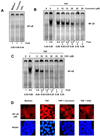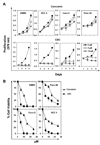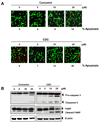Cyclodextrin-complexed curcumin exhibits anti-inflammatory and antiproliferative activities superior to those of curcumin through higher cellular uptake
- PMID: 20599780
- PMCID: PMC2923254
- DOI: 10.1016/j.bcp.2010.06.022
Cyclodextrin-complexed curcumin exhibits anti-inflammatory and antiproliferative activities superior to those of curcumin through higher cellular uptake
Retraction in
-
Retraction notice to “Cyclodextrin-complexed curcumin exhibits anti-inflammatory and antiproliferative activities superior to those of curcumin through higher cellular uptake” [Biochem. Pharmacol. 80 (2010) 1021–1032].Biochem Pharmacol. 2016 Feb 15;102:142. doi: 10.1016/j.bcp.2015.11.007. Epub 2016 Feb 20. Biochem Pharmacol. 2016. PMID: 26985464 Free PMC article. No abstract available.
Abstract
Curcumin, a yellow pigment present in the spice turmeric (Curcuma longa), has been linked with multiple beneficial activities, but its optimum potential is limited by poor bioavailability, in part due to the lack of solubility in aqueous solvents. To overcome the solubility problem, we have recently developed a novel cyclodextrin complex of curcumin (CDC) and examined here this compound for anti-inflammatory and antiproliferative effects. Using the electrophoretic mobility shift assay, we found that CDC was more active than free curcumin in inhibiting TNF-induced activation of the inflammatory transcription factor NF-kappaB and in suppressing gene products regulated by NF-kappaB, including those involved in cell proliferation (cyclin D1), invasion (MMP-9), and angiogenesis (VEGF). CDC was also more active than free curcumin in inducing the death receptors DR4 and DR5. Annexin V staining, cleavage of caspase-3 and PARP, and DNA fragmentation showed that CDC was more potent than free curcumin in inducing apoptosis of leukemic cells. Antiproliferative assays also demonstrated that CDC was more active than free curcumin in suppressing proliferation of various cancer cell lines. The cyclodextrin vehicle had no effect in these assays. Compared with free curcumin, CDC had a greater cellular uptake and longer half-life in the cells. Overall we demonstrated that CDC had superior attributes compared with free curcumin for cellular uptake and for antiproliferative and anti-inflammatory activities.
Copyright (c) 2010 Elsevier Inc. All rights reserved.
Figures








References
-
- Kunnumakkara AB, Anand P, Aggarwal BB. Curcumin inhibits proliferation, invasion, angiogenesis and metastasis of different cancers through interaction with multiple cell signaling proteins. Cancer Lett. 2008;269:199–225. - PubMed
-
- Ralhan R, Pandey MK, Aggarwal BB. Nuclear factor-kappa B links carcinogenic and chemopreventive agents. Front Biosci (Schol Ed) 2009;1:45–60. - PubMed
-
- Aggarwal S, Ichikawa H, Takada Y, Sandur SK, Shishodia S, Aggarwal BB. Curcumin (diferuloylmethane) down-regulates expression of cell proliferation and antiapoptotic and metastatic gene products through suppression of IkappaBalpha kinase and Akt activation. Mol Pharmacol. 2006;69:195–206. - PubMed
Publication types
MeSH terms
Substances
Grants and funding
LinkOut - more resources
Full Text Sources
Other Literature Sources
Research Materials
Miscellaneous

